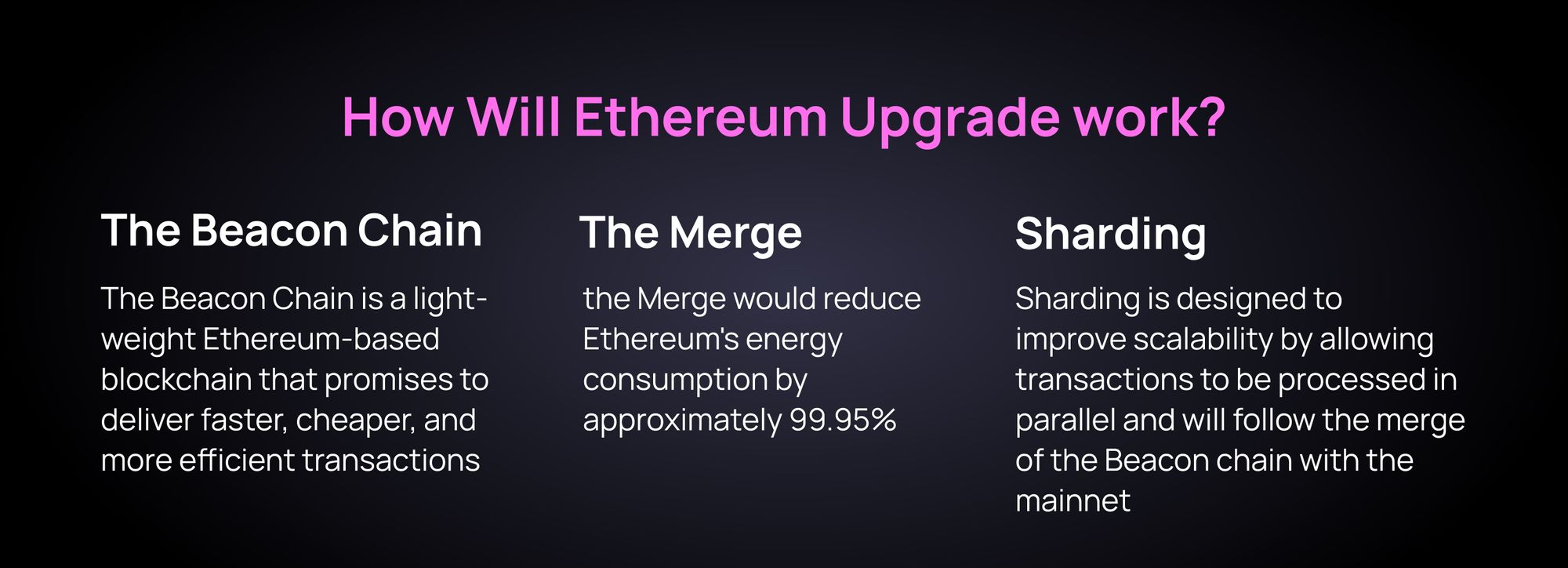How the New Ethereum Upgrade Could Radically Change Mining Forever

With Ethereum's new hard fork upgrade, The Merge, set to go live later this year, the mining process for the cryptocurrency is set to change radically. The new upgrade will move Ethereum from a proof-of-work (PoW) system to a proof-of-stake (PoS) system, which could have a significant impact on how miners operate. In this article, we'll look at what the new upgrade will mean for miners, the mining process and when the upgrade is expected to be shipped.
What is Ethereum upgrade?
Ethereum is planning to upgrade its blockchain to improve efficiency and security. The new standard, Ethereum 2.0, has been in development for a while and will involve a lot of changes. One of the biggest changes will be to the mining process, which will change significantly as a result of the new Casper consensus mechanism. In the meantime, Ethereum will move from a PoW to a PoS consensus. This will work because miners will no longer be required to validate transactions, but will instead be chosen randomly. Instead of mining for blocks, staking validators will be selected to validate and record transactions. This will be known as Proof-of-Stake (PoS) mining.

How Will Ethereum Upgrade work?
The Ethereum upgrade aims to make the Ethereum network more secure, scalable, and sustainable; with a set of upgrades to achieve this (each interconnected). The Beacon chain, The Merge, and Sharding are all the three central portions of the upgrade.
The Beacon Chain
The Beacon Chain is the latest upgrade to the Ethereum network. It was shipped on December 1, 2020. The Beacon Chain is a lightweight Ethereum-based blockchain that promises to deliver faster, cheaper, and more efficient transactions. The Beacon Chain uses Proof of Stake (PoS) as its consensus mechanism, which means miners are no longer needed to maintain the network. Instead, staking wallets process transactions on the Beacon Chain. Ethereum will become substantially safer and more decentralized when it switches to proof-of-stake.
Staking entails you using ETH to launch a validator software. You will operate node software as a Staker, which processes transactions and creates new blocks to the chain. Since the Beacon chain was shipped, it has stayed as a separate chain from the Ethereum mainnet (currently in use). The major part of the Ethereum upgrade is to replace the proof-of-work algorithm currently in use on the execution layer (mainnet) with the proof-of-stake that the Beacon chain introduced. So, the consensus layer will be merged with the existing execution layer to eliminate the use of mining.
The Merge
The Merge is a significant upgrade to the Ethereum network that has been in the works for years. The Merge is the merger between Ethereum's new Beacon Chain proof-of-stake consensus layer with its current execution layer (the Mainnet currently in use). Instead of employing energy-intensive mining (the Merge would reduce Ethereum's energy consumption by approximately 99.95%), it uses staked ETH to safeguard the network. The Merge is planned to happen in September 2022 depending on the final testnet merge.
The Merge will be an incredibly exciting step toward achieving the increased scalability, security, and sustainability goals of Ethereum.
Sharding
Ethereum sharding is a process of partitioning the Ethereum blockchain into multiple shards, each of which contains its transaction history. Sharding is designed to improve scalability by allowing transactions to be processed in parallel and will follow the merge of the Beacon chain with the mainnet. Layer 2 solutions can offer reduced transaction fees while using Ethereum's security thanks to sharding.
The new sharding design for Ethereum is called Danksharding. Instead of having a predetermined number of shards with different blocks and different block proposers for each, Danksharding has a single proposer which selects all transactions and data that go into each slot. This means that no matter how many transactions are on a shard, the block is still going to be the same size. The blocks will be formed from transactions and data from each of the shards. Ethereum sharding is still in development and is not yet available on the mainnet.
FAQs
Will The Merge reduce gas fees?
No, The Merge won't lower gas fees because it only alters the consensus mechanism, not expands the network capacity.
Why is Sharding happening after The Merge?
Only when a proof-of-stake consensus mechanism is in place can sharding be introduced to the Ethereum ecosystem safely. Staking was first introduced by The Beacon Chain, and once it is "merged" with the Mainnet, it will open the door for sharding to help Ethereum expand even further. As a result, the Mainnet is healthy for shard chain development, with layer 2 solutions boosting the scalability.
Trade Crypto on Bit.com
With the mission to create an entire ecosystem for blockchain-based financial transactions, Bit.com stands as the world’s 2nd largest crypto options exchange.
Sign up on Bit.com, and switch on your future.

